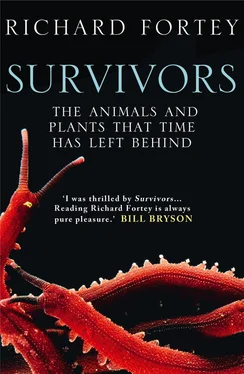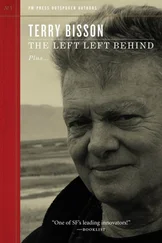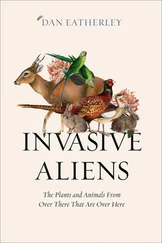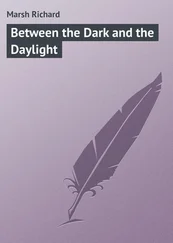A notice at the top of the cliffs points the way (a quarter of it had blown away in the last gale) accompanied by a pinned-up sheet of paper instructing visitors to ‘remove footwear before visiting fossil bearing surfaces’. I confess that the idea of taking off one’s boots in a howling squall to safeguard fossils that had survived since the Precambrian had its funny side. In the event we are provided with a pair of rather fetching blue over-socks. Visits to the famous fossils are now strictly supervised, as the site is now part of the Mistaken Point Ecological Reserve, and quite right too. Canadians are strict about protecting their national natural heritage. There is an architect-designed Visitor Centre to explain all to those who have made the trip. I climb down onto the best surface, in my special socks, and it takes a while to identify what to look for, but once they are pointed out the fossils are obvious. Any doubt that they were of organic origin was immediately banished from my mind. The fossils are strewn over the black surface of the gently dipping former sea floor almost as if laid out for the convenience of future inspections: one here, one there. The most conspicuous look like leaves or fronds, and are about the same size as a domestic Aspidistra leaf or some other showy tropical pot plant. They are pleated within, and the closer one looks the more subdivisions inside the ‘leaf’ one begins to see. Such spindle-shaped fossils are the commonest type. There are more than a thousand of them on display under the Newfoundland sky. They were named Fractofusus misrai in 2007, four decades on from their original discovery, thereby commemorating the discoverer in perpetuity in the species name. The name Fractofusus is quite descriptive – the ‘fusus’ part refers to the fusiform (spindle-like) shape of the whole organism, and the ‘Fracto’ part to the fact that it appears to have a fractal structure. Fractals, those intriguing mathematical entities recognised by Dr Benoit Mandelbrot in 1980, are shapes that seem to repeat themselves precisely when the scale is focused down to a smaller level. So, the largest primary divisions within Fractofusus are subdivided into identical-looking smaller frondlets, and those in turn into identical-looking ‘sub-frondlets’, and so on. It seems that these Precambrian organisms favoured this kind of structure; indeed, Martin Brasier of Oxford University has shown rather ingeniously that several of the organisms at Mistaken Point can be understood as a kind of three-dimensional origami played out by folding such fractal objects in different ways. But there are also some frond-like organisms that seem to be attached to the former sea floor by a kind of disc-shaped holdfast. Charniodiscus masoni was perhaps the earliest Ediacaran species to be recognised – from Charnwood Forest in Leicestershire in England, as the generic name should make clear (like Misrai, the species name is after its discoverer). The same ‘frond’ is known from a very large number of Ediacaran localities, including several in the Ediacara Hills themselves, so it is almost totemic for this early and vanished marine world. The disc is thought to have held the organism in place while the frondose part was maintained aloft in the water current. There are several additional forms from Newfoundland that have their counterparts in Leicestershire, but since the latest reconstructions of the later Precambrian world place these areas quite close together geographically this is not as surprising as it may seem at first. Some other oddities are pointed out to me, one is a kind of plate with tumid blobs arranged all over it. It was called informally ‘the pizza’. The name reminded me that in my excitement I had not yet eaten lunch, so there I sat on an Ediacaran sea floor eating a cheese sandwich, looking out to sea on a perfect day while fulmars wheeled past on a light breeze. For a palaeontologist, it doesn’t get much better than this. I realise that whatever we eventually make of these strange fractal beings, it cannot be doubted that there was a lot of conspicuous life in the later Precambrian, but apparently no relatives of velvet worms. These special fossils position a time line in our story; they offer a calibration for evolutionary invention.
I wonder what lucky circumstances account for the preservation of the fossils. After all, they are soft bodied. They could have vanished leaving no trace. My guides tell me that the area now so often coolly fog-bound was volcanically active in those distant days. Periodic ash falls cascaded into the sea and rapidly killed off and buried the Ediacaran fauna. They point out the Charniodiscus bending over in a common direction flattened by the incoming volcanic Armageddon. I should have noticed this before. Each fossil-bearing sea floor is the record of one tragic moment for the Ediacaran animals, though it is no less than a miracle for us intelligent primates. Volcanic rocks have another property in addition to their role as natural undertakers; they yield minerals that can be used to obtain a radiometric age for the eruption. They both write the obituary and record the date. A time label of 565 million years ago has been obtained recently from an ash layer immediately above one of the best fossil-bearing beds. This is more accurate than can be achieved with many younger deposits, because datable volcanic rocks are not commonly interleaved with fossil-rich sedimentary rocks. Given that the best date for the base of the Cambrian Period is 542 million years ago, the Newfoundland rocks are only twenty-three million years older. I use the word ‘only’ advisedly; although this might seem like a long time, it is a short span in the history of the horseshoe crab or velvet worm. Even if we went back twenty-three million years from the present day we would readily recognise a world of mammals, birds, butterflies, and flowers; and our own distant ancestors were already in the trees. But the world of Mistaken Point seems to have nothing to do with the marine world familiar from Cambrian strata, with its arthropods like trilobites, together with molluscs, brachiopods, and echinoderms, ancestors of today’s sea urchins and feather stars, not to forget the distant relatives of velvet worms.
It is no wonder that an attempt to understand the Ediacaran world has attracted the attention of researchers around the globe. Some facts have become quite well established, but there remain many disputes, which is hardly surprising when considering scientific forays into such mysterious and ancient environments. In fact, the stuff of science is disagreement. If there were no disputes there would be no incentive to drive scientists out (without shoes) onto exposed Atlantic shores in order to crouch over cold wet rocks for hours on end. They want to get one step ahead in the race for the truth. However, most specialists do concur that the Ediacaran sea floor was very different from the seabed on the continental shelves today. The surface was coherent, even rubbery, due to a thin-skin veneer composed of bacterial mats. Sediments were almost cling-film wrapped, and holdfasts probably got a good purchase on this kind of surface. There is also a less universal consensus that the reason for this skin-like surface was that a range of burrowing organisms had not yet appeared to churn up the sediment. The sea floor nowadays is often a mass of so-called infaunal animals that live in the silt of the seabed and have a vital role to play in the food chain. Think of the huge flocks of waders that strut around on muddy estuaries when the tide is low, pecking down into the mud – not every dunlin has to rely on horseshoe crab eggs. Little churners and burrowers, especially marine polychaete worms, oxygenate the lower layers of the sediment as they work away. In the absence of such activity, an anaerobic layer soon develops beneath the surface, which can be recognised by the preservation of fine, horizontal layers when the sediments eventually harden into rock. Many Precambrian strata do indeed look like this – though by no means all. Sometimes the more fine-grained sedimentary surfaces betray a wrinkly skin, which is finely puckered, almost like the skin of an elephant, enabling us to visualise the gummy bacterial surface, although the minute organisms that made it are not preserved. These curious sea conditions have been ingeniously invoked to explain the preservation of many Ediacaran soft-bodied fossils. After a sudden overwhelming event – it could be a sudden slurry of sediment or a volcanic ash fall – the organisms are entombed, and a new mat then quickly grows on top of the grave sealing the dead animals in the sediment. Then the reducing conditions that inevitably ensue in the absence of wormy disturbance help to mobilise iron in the sediment in a form that migrates to make a kind of ‘death mask’ around the potential fossils before they have decayed away. The endurance of so many soft-bodied organisms certainly implies a lack of those scavengers that make short work of dead bodies in today’s oceans. As for the texture of the Ediacaran organisms, they may have lacked shells but they seem to have been membranous, possibly even quite tough. Some scientists believe that they were divided into chambers rather like an old-fashioned quilted eiderdown. Their apparently fractal structure is probably a reflection of a particular style of growing, whereby the same set of rules are repeated over and over. It may just be a simple way of growing big. However one looks at them these organisms do seem irredeemably strange.
Читать дальше












